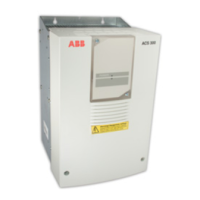ACS 300 User’s Manual 77
Chapter 8 - Fault Tracing
This chapter describes the ACS 300 fault indications and fault
memory. It also explains how to trace faults.
Fault Indications
The ACS 300 continuously monitors itself for faulty operation. If a
fault condition should arise, a fault indication is displayed, the
fault LED illuminates and the ACS 300 waits for the operator to
acknowledge the fault before resuming operation.
Fault Resetting
An active fault can be reset either by pressing the keypad
button, deactivating the Start input (DI1) or switching the input
voltage off for a while. When the fault has been removed, the
ACS 300 will resume normal operation. If the fault has not been
removed, the ACS 300 will trip again. For automatic fault reset,
refer to parameter RESTART # on page 66.
Note! If the Start command is active and the fault has cleared,
fault resetting starts the drive.
Some faults require you to cycle the power off and on once
before the fault can be cleared. Proper fault reset action is given
in chapter “Fault Tracing” on page 78.
Fault Memory
When a fault is detected, it is stored so that it can be reviewed at
a later date. The last three faults are stored on Page 1 parameter
FAULT MEMORY.
Scrolling through the FAULT MEMORY does not erase the FAULT
MEMORY. The oldest fault indication is automatically erased
when a new fault occurs.
Note! Undervoltage fault is stored in FAULT MEMORY if the fault

